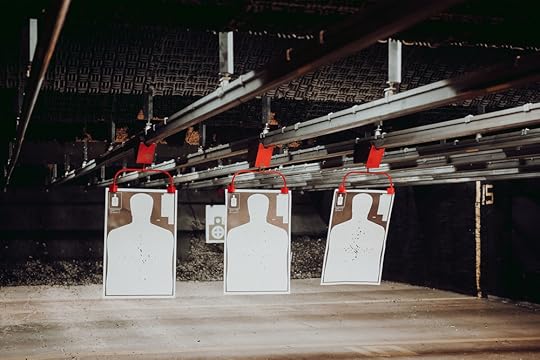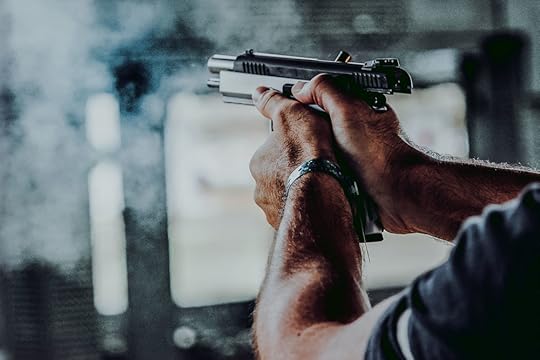Sean Parnell's Blog
July 24, 2018
Bridging the Gap: To Combat Veterans Suicide, Cultural Change Needed

Bridging the gap
by Sean Parnell
In April, my Army unit that served in Afghanistan passed a dark milestone: we’ve now lost more men to suicide than we lost in combat.
During a 485-day deployment in 2006-2007, a single member of our platoon was killed, though many, myself included, were wounded—we had an 85 percent casualty rate. But since returning home, three members of my platoon have taken their own lives. To grapple with the fact that we lost three times as many men to post-war suicide than in combat is to begin to grasp the true burden of war that veterans carry.
despite funding increases for mental health treatment, far too many veterans are still unable to access that treatment though the VA
I write and speak extensively on a wide range of subjects related to military affairs and veterans’ issues. And nothing I’ve ever spoken about has generated such a strong response as when I discuss suicide in the veterans’ community.
Veterans approach me at speaking engagements, or send me e-mails and notes via social media, telling of how they or their friends have struggled with suicidal impulses. I’ve had too many conversations with grieving parents and spouses who watched helplessly as a loved one lost that struggle.
According to the most frequently cited estimate, 22 military veterans commit suicide every day. That number comes from a report prepared by researchers with the U.S. Department of Veterans Affairs (VA), and it represents only a best estimate based on limited data, since there is no comprehensive tracking of veterans after they leave the service. Many believe the true number to be significantly higher.
The 22-per-day figure includes a substantial number of older veterans. But indications are that the trend of suicide among younger vets is a growing problem, as many of these veterans struggle with the readjustment to civilian life after enduring nearly constant deployments and the stress of combat. In a 2014 survey of Iraq and Afghanistan veterans, half said they knew another veteran who had attempted suicide.
Why would this be? One frequent refrain I hear is that “the government should be doing more” to prevent suicide among veterans. That’s partly true—policymakers should certainly strive to ensure that veterans who are at risk get the effective intervention and support they need.
But I also know that’s not the entire answer. The difficult reality is that while Washington policymakers and the VA do in fact bear some responsibility for the trend (despite funding increases for mental health treatment, far too many veterans are still unable to access that treatment though the VA), it won’t be solved with simply “more funding” or “more programs” aimed at preventing veterans’ suicide.
To address the crisis of veterans’ suicide, we need to rethink how we reintegrate veterans into civilian society after their service. Far too many veterans return home, frequently from high-stakes combat situations, only to find themselves ignored, misunderstood and alienated from their fellow Americans.
Which is to say we don’t have a policy shortfall—we have a cultural shortfall.
A veteran returning from war today is unlikely to receive a hero’s welcome. Instead, he or she is shunted into a maze of bureaucracy for VA care, job training support, educational opportunities and other public benefits. These are all fine things, and obviously well-intended—but they do little to create a sense of true cohesion between those who have served and the larger society.
it’s time for veterans and civilians alike to have a shared conversation about the real costs of war
Compared to earlier wars in the American experience, the most recent conflicts have been relatively limited in their impact on most people’s lives. Today, only .4 percent of Americans are serving in the military. Contrast that to, say, the World War II era. At that time, virtually every community, neighborhood and family was touched in some way by service and sacrifice. That’s far less true today—which explains the dramatic gap between military and civilian culture.
It’s a cultural gap that needs bridging, and that begins with mutual respect and understanding. Too often, civilians are hesitant to ask veterans about their combat experiences, because they fear saying the wrong thing. At the same time, too many veterans “shut down” and decline to talk about their service with civilians, assuming they’ll never understand.
But that understanding doesn’t just happen. It has to be nurtured into existence and allowed to grow—which means it’s time for veterans and civilians alike to have a shared conversation about the real costs of war, and to begin bridging the gap that separates us.
Recognizing, understanding and crossing that gap is one key to combating the problem of suicide among veterans. And we must understand the problem is not one that will be solved simply by passing more legislation or throwing more money at it—it’s a cultural issue that demands a cultural solution.
June 12, 2018
How not to look like an idiot at the range.

How not to look like an idiot at the range.
by Sean Parnell
So, you bought a gun
Part 1: How NOT to look like an Idiot at the rangeIn our last installment, we talked about buying a gun. Assuming you are now the proud owner of a new bang stick, you are ready for some trigger time. It is important to realize that owning a pistol and being proficient with it are two different things. In fact, they are the difference between life and death. The only way to become comfortable with your steel is to go to the range.
Unfortunately, besides the gun store, the range is the second most intimidating place for a virgin pistolero. Why? Because it’s full of douchebags. The only place I have ever witnessed a greater collection of morons is at the gym. Let that sink in for a second.
The range is a sacred place that offers the ability to hone your skills. The most important thing to remember is: If it is your first time, don’t be intimidated- everyone has been where you are now. A wise man once said, “the longest journey begins with a single step.
Safety: Like I said before, most people at the range have no idea what they are doing. It’s kinda like sex, practice makes perfect. While most ranges do a decent job screening people coming through the door, the safety aspect is on you.
If you have already gotten your concealed carry you know to treat every firearm like it is loaded. I’m going to go a step further, and offer some BIG BOY RULES:
Never point your pistol at something you don’t plan on breaking, buying or killing.Never put your finger on the trigger until you are pointed at your target. If you don’t believe me, and want to see what happens go to YouTube and type in Firearm Fails. 99% of the time, a pistol fired because some dumbass pulled the trigger.
Set attainable goals or train like you fight. Most gunfights take place between 5 and 7 feet. Think about that when you go to the range and see people trying to snipe targets with a .38 Special. If you are just there to screw around, then by all mean, feel free to stop reading, but if you are serious about mastering your firearm you have to build a foundation.
If someone wants to see your pistol, make sure you hand it to them with the magazine out, and the chamber locked to the rear. If someone hands you a loaded firearm, it is a dead giveaway that they don’t know what they are doing.
Check to make sure your firearm doesn’t have a magazine in it, and the chamber is locked open. Sound familiar? There is a reason- because you don’t know these people. Just because you are at the range, doesn’t mean the person next to you isn’t a psycho or a serial killer. It also doesn’t mean he or she knows what the hell is going on. If you are handed a firearm, repeat steps 4 and 5.
Do NOT EVER WALK DOWNRANGE- EVER. The caveat to this rule is if you are taking a class somewhere, and the instructor tells the entire class to move as one unit to the target line.
Don’t try some stuff you just saw on YouTube. Pretending you are Wyatt Earp at the OK Corral is the best way to shoot yourself in the leg. Trust me, I’ve seen it.
If someone does walk down range, put your pistol down, and step back. It is hard to explain why you shot the guy, decked out in multicam, in the back. Instead, wait until he or she comes back to the firing line and give them your best, “Are you serious dude” look.
Avoid anyone who smells of booze. The flip side is, don’t go to the range smelling of booze.
Remember: No one outranks safety.
May 23, 2018
Make the VA Accountable

Make the VA Accountable
by Sean Parnell
After watching scandal after scandal unfold at the U.S. Department of Veterans Affairs over the past several years, I have a single overriding question: When will Washington step up to address the problems of this dysfunctional department?
In fact, a viable solution is right now awaiting action in the U.S. Senate — the VA Accountability Act of 2015, a bipartisan bill passed by the House in July to hold VA employees accountable for poor performance. It’s time for the Senate to follow suit to put these much-needed reforms to work on behalf of veterans.
As an Afghanistan combat veteran and an advocate for veterans’ issues, I talk regularly with men and women who describe endless difficulties in dealing with the VA. Their complaints include long waits for services, a lack of communication from an unresponsive bureaucracy, delayed benefit payments and more.
As any military veteran will tell you, accountability is the key to high performance...Unfortunately, awareness of that principle has been lost at the VA
But even if you haven’t spoken with a veteran about the VA, you probably have seen the many media reports about the department’s failures.
Here in Pennsylvania alone, perhaps you’ve seen reports of a Legionnaire’s disease outbreak at the Pittsburgh VA in 2011-2012 that left six veterans dead and sickened at least 16 others. Meanwhile, the Philadelphia VA is the target of an extensive inspector general probe centered on data manipulation, allegations of shredded applications and years-old claims applications that have never been opened.
The failures are well-documented, but what’s lacking is any sense of accountability for those failures. Despite the many reported and confirmed scandals at VA facilities nationwide, terminations of employees for cause are rare. At most, problem workers are transferred or, in some cases, allowed to retire with full benefits.
Here’s an example of how it works: In 2014, Americans were shocked to discover widespread fraud and data falsification at VA facilities nationwide, which led to veterans having their health care treatments delayed or denied.
Yet one year later, only three employees had been removed from their jobs as a result of the scandal. As The New York Times reported this spring, “The department punished a total of eight of its 280,000 employees for involvement in the scandal. One was fired, one retired in lieu of termination, one’s termination is pending, and five were reprimanded or suspended for up to two months.”
As any military veteran will tell you, accountability is the key to high performance — people must understand there will be rewards for success and consequences for failure. Unfortunately, awareness of that principle has been lost at the VA.
The VA Accountability Act would restore the basic leadership principle of accountability by giving the VA secretary the authority to remove an employee swiftly for misconduct or poor performance. It also includes enhanced protections for whistleblowers by creating disciplinary standards for any VA official who attempts retaliation against a VA employee who exposes wrongdoing or failure at the department. These are overdue reforms.
It’s time to put veterans back at the center of the VA mission
Of Pennsylvania’s two senators, only Sen. Pat Toomey has thus far declared his support for the VA Accountability Act. I hope Sen. Bob Casey, who’s been a reliable supporter of veterans in demanding VA action on the disability-benefits backlog, will soon follow suit.
I have never been a knee-jerk critic of the government, especially of the VA. In fact, I know personally how good the VA can be when it’s working as it’s supposed to work. When I returned from Afghanistan in 2007, wounded and with a disability rating, the professionals at the VA facility in Butler provided me quality care and support, for which I am deeply grateful.
But I also recognize that too many of today’s veterans don’t have the same experience — and by nearly every metric, the VA’s performance has deteriorated dramatically since 2008. That’s in spite of a significant increase in funding, with the VA’s budget nearly doubling since 2006 to $59 billion.
The VA has lost sight of its core mission, choosing to protect bureaucrats rather than supporting veterans. It’s time to put veterans back at the center of the VA mission.
To do that, the VA needs a culture change — and creating a culture of results starts with expecting greater accountability for all VA workers. The VA Accountability Act of 2015 would give the department its best chance at meaningful reform. The Senate should move swiftly to pass this vital legislation.
May 3, 2018
People You Might Encounter at the Range.

People You Might Encounter at the Range.
by Sean Parnell
Poserus Firearmus
I guarantee that on your first trip to the range you are going to come in contact with this guy. He is a douche, avoid him.
Typically he will be decked out in the latest Gucci gear, tight fitting T-Shirt and have a table full of rifles and pistols. They will try and intimidate you with their crap, and the best way to handle them is to discreetly check out their targets. Are they hitting anything? Are they shooting tight groups? Are they shooting a Desert Eagle one handed, and behind the back? Or are they violating every single one of the rules we just went over?
Once again, go to YouTube and check out firearm fails before you go to the range. Bet you see a ton on your first visit.
Mr. Free Advice
Try to find a lane far, far away from this person.
This guy wants to talk because he likes to hear his own voice. Most likely he is going to fit in the poser category and will appear to know what he is doing. He will offer you all kinds of grip, sight alignment, trigger squeeze, and quick draw tips. My rule at the range is: IF I DON’T KNOW YOU, I’M NOT GOING TO TALK TO YOU. Sound harsh? Think about it this way, would you go to someone’s job and offer them advice on how to do it better?
The Master BlasterThis person is a total wreck, and is only there to blast as much ammo as fast as possible. Try to find a lane far, far away from this person.
Check out their targets, and if every round is going through the same hole, check out what he is doing
The Old Timer
In my experience these dudes typically have it going on, and are at the range for a specific reason. Usually, it is to practice for a completion. Check out their targets, and if every round is going through the same hole, check out what he is doing, and then go research it.
The NoobThis guy is all kinds of messed up. He says, “the hell with safety” and his groups look like he or she is shooting buckshot. Everything about him is dangerous, and his gear is fresh out of the box crap. Usually, he is shooting a .45 and spends most of his time filling mags and firing as fast as possible- always at the head.
His lane is full of expended brass, and he leaves his target hanging up because he figures the staff will clean up after him. Usually, his gun jams every other shot because he doesn’t oil it, and when he changes magazines it looks like he is trying to pick a lock in the dark.
Please don’t be this guy. If I see you, I won't talk to you because I’m there to train. But if our eyes do meet I will be the guy with the Are you serious, dude look.
October 13, 2016
Talkers vs. doers: Time to ignore the Kaepernicks of the world

Talkers Vs. Doers
by Sean Parnell
When San Francisco 49ers quarterback Colin Kaepernick declined to stand for the national anthem, to protest what he described as a nation that “oppresses” its minority populations, he illustrated the deep division in American life in 2016.
But probably not in the way he intended to. Kaepernick’s ostentatious and self-aggrandizing stunt underscores how we’re now divided into a nation of Talkers — those who claim to see a problem and seek to launch an endless “conversation” about it — and a nation of Doers — those who see a problem and take action to address it.
Kaepernick is an example of the classic Talker. A gifted athlete who has risen to the heights of his profession, he is paid tens of millions of dollars to play what is fundamentally a game for children, for the diversion and delight of fans nationwide.
Kaepernick is nothing more than a Talker, someone who sacrifices nothing and takes no action to address actual social needs.
Like far too many highly paid, pampered celebrities, Kaepernick has evidently deluded himself into believing his commendable success in the entertainment field makes him a moral beacon, a voice for the downtrodden. He’s mistaken. Colin Kaepernick is nothing more than a Talker, someone who sacrifices nothing and takes no action to address actual social needs.
By contrast, the best illustration of the Doer Nation right now can be found in the battered southern state of Louisiana, where earlier this month torrential rains resulted in a catastrophic flooding disaster. Communities were destroyed, lives and livelihoods lost, and tens of thousands of people have been displaced.
Against this forbidding backdrop of human suffering, the Doers of the Bayou State didn’t remain seated — they stepped up.
The so-called “Cajun Navy,” a spontaneously organized array of volunteers in small sporting boats who performed heroically during the Hurricane Katrina disaster a decade ago, sprang into action to help with rescue, recovery and relocation efforts. Members of the National Guard deployed to coordinate and support emergency efforts. Churches, communities and neighbors pulled together in a web of mutual support and reinforcement.
In one particularly compelling video circulated widely online, a group of men struggle to rescue a woman and her dog trapped in a car that is rapidly submerging into the water. As the car sinks, one of the men leaps into the water, at great risk to himself, to help the woman and her beloved pet to the surface.
One wonders when watching scenes like this if the comfortable Talkers like Colin Kaepernick, paid millions of dollars to sit on a bench, have any idea what true courage, humility, service and sacrifice look like.
My own military experience taught me a lot about the difference between the Doers and Talkers. Leading a combat platoon in Afghanistan a decade ago, I saw a group of young men from a range of backgrounds, races and religions pulling together in spite of their differences.
Many of the men I served with came from underprivileged backgrounds. Had they chosen to do so, they probably could have elected to see themselves as victims of oppression. But that would have required them to be Talkers, rather than Doers, and they didn’t have time for that. It wasn’t in their nature, anyway.
That’s an outlook captured nicely by another NFL player, Alejandro Villanueva of the Pittsburgh Steelers here in my home state of Pennsylvania. Like me, Villanueva served as an infantry officer in Afghanistan. His perspective on the privileged Kaepernick’s protest should be required reading for Talkers everywhere.
One can’t help but notice that none of their sanctimonious chatter ever brings any real solutions to our challenges.
“I agree that America is not perfect, I agree there are lot of issues with minorities in this country, I agree we should do something about it," Villanueva told the Pittsburgh Post-Gazette. "But I don't know if the most effective way is to sit down when the national anthem of the country that is providing you freedom and providing you $60 million a year is the best way to do it when there are black minorities that are dying in Iraq and Afghanistan and protecting our freedom for less than $20,000 a year.”
It’s unfortunately true that the Talkers get a lot of attention in today’s world. Political figures of all stripes who make bold promises and fail to deliver; arrogant celebrities and sports figures who tediously lecture the rest of us on our ostensible shortcomings; journalists and media players who delight in sowing polarization and division. One can’t help but notice that none of their sanctimonious chatter ever brings any real solutions to our challenges.
That’s because it’s the Doers who are making the real difference in our nation today. Perhaps it’s time to give them more of our attention, and far less to the likes of Colin Kaepernick and the rest of the Talking class.



